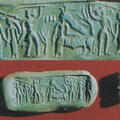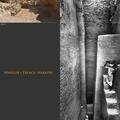Indus Cylinder Seals
"The cylinder seals of Mesopotamia constitute her most original art," wrote the scholar Henri Frankfort, and much the same has been said about the very different square stamp seals used by the ancient Indus civilization. Cylinder seals are "small, barrel-shaped stone object[s] with a hole down the center, rolled on clay when soft to indicate ownership or to authenticate a document . . . used chiefly in Mesopotamia from the late 4th to the 1st millennium BCE." Many of the handful of cylinder seals found at ancient Indus sites or Mesopotamian ones with Indus themes are collected below.
1.




